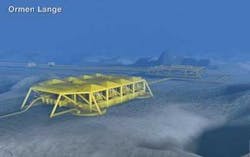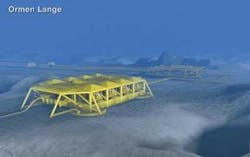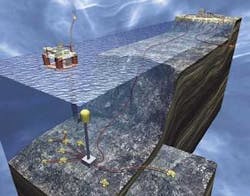Ormen Lange gives Hydro enormous challenge
Difficult subsea-to-shore pipeline route
Steve Sasanow
Special to Offshore
Norsk Hydro has never been shy of taking on a technology challenge. Norway’s number two operator executed the offshore industry’s very first long-distance tieback project - TOGI - nearly 15 years ago. It followed up with the giant Troll West oil development, which includes two floating production semis and upward of 100 subsea horizontal wells producing from the narrowest of pay zones.
And, of course, don’t forget Troll Pilot, the first fully operational subsea processing system.
Hydro now has the opportunity to take on another challenging offshore project, the Ormen Lange gas field off mid-Norway. The second biggest gas accumulation in Norway - more than 400 bcm and over 180 MMbbl of condensate - Ormen Lange brings Norway into the deepwater arena with a development in waters ranging from 850 m to 1,100 m.
There is very little that is straightforward about this project. This is a nominal 100-km subsea-to-beach scheme with seabed structures that have to be installed in and cross one of the most difficult seabed areas, created by the Storegga submarine slide. Caused by an earthquake over 8,000 years ago, this slide has created an undulating sea bottom that will provide a tremendous challenge for routing and installing the twin 114-km, 30-in. pipelines from the field to shore. In addition, there are two 6-in. pipelines delivering massive quantities of monoethylene glycol (MEG) to the field and a pair of 120-km field umbilicals. Span correction will be a major enterprise during the pipeline installation program.
Almost the entire offshore construction sector is involved in this project. Allseas Marine Contractors, Saipem, Stolt Offshore, and Subsea 7 all have a piece of the installation program.
As with all long-distance tieback projects, flow assurance and the controls system are the key elements of the subsea system. With water temperatures below zero on the seafloor, the threat of hydrate formation and ice plugs is a considerable worry, even though the gas at Ormen Lange is considered to be relatively dry. In addition to continuous delivery of MEG into the pipeline system, water-in-gas meters are installed at each well, so that the operations team can monitor water production.
FMC Kongsberg Subsea is delivering the subsea hardware for Ormen Lange. Although FMC is seen as leading the international marketplace in deliveries of subsea production equipment, this is the first LDT project that it has had to execute. With uptime and availability a priority, FMC should benefit from the intensive program of qualification testing that it had to undertake of the subsea hardware for BP’s Thunder Horse project in the Gulf of Mexico.
This is an optical/electro-hydraulic control system. The main communication link is via optical fibers with a “comms on power” backup. The system has to accommodate interfacing a host of ancillary items - christmas tree sensors (pressure and temperature), water-in-gas meters, sand detectors, and mass flow meters - and it will make use of the newly agreed IWIS standard control system interfaces.
The initial phase of Ormen Lange will involve the installation of two eight-slot templates with four wells each connected to an infield pipeline end termination (PLET), which is the tie-in point for the export system. The initial wells will be fitted with horizontal subsea trees with the biggest completions - 9 5/8 in. - available in the market. Such completions have only been used before by Shell on its subsea gas developments offshore Malaysia.
There are options in FMC’s contract to supply eight additional trees to expand the initial production phase, although all wells after the first phase will only have 7-in. completions. The system also has the flexibility to be expanded with an additional two six-slot templates with four wells each. One of these templates would link up to the PLET, while the other would tie in into the export system via a tee.
With high production reliability an important issue in gas deliveries, the system has significant redundancy. There is an umbilical to each of the templates and a crossover link that could provide control to either template in the event of one umbilical being damaged. Likewise, there is a MEG line to each template and a crossover link.
One of the first construction activities on the project will take place this coming summer with the installation of three suction anchors. These anchors will be used for running guide wires for installing the drilling templates. This might seem like a minor activity, but it will see the first operational application of a new winch system, developed by Odim in Norway, that uses fiber rope as the lifting medium rather than steel wire.
There is a considerable amount of interest in fiber rope deployment systems for deepwater lifting operations. The Odim winch, dubbed the Cable Traction Control Unit (CTCU), combines variable speed operations with a system that eliminates slip and spin between the rope and the winch.
While the subsea system is the heart of the Ormen Lange project, it is not the driver. The driver is gas sales to the UK market for delivery via Centrica’s gas terminal at Easington on the east coast of the country. And the engine for that driver is the Langeled pipeline.
This is the longest gas pipeline system in the world, measuring 1,200 km from Nyhamna on the west coast of Norway via the Sleipner offshore complex to Easington. The system can handle 20 bcm/yr, beginning in 2006, through a system that is 42-in. from Nyhamna to Sleipner and 44-in. from Sleipner to Easington. The larger size on the UK side of the network allows for other suppliers, in addition to the Ormen Lange license group, to put gas through the system.
In the short term, Ormen Lange will be an impressive achievement, but it won’t break any records. There is more to come, though. Part of the long-term development - about eight to 10 years after production begins - will be the need for some form of compression. Although the plan for development and operations submitted by Hydro suggests an offshore platform, the base case is expected to be subsea gas compression.
The Ormen Lange license group, under the Demo 2000 technology demonstration program, is supporting work by Framo Engineering on a wet gas compressor. The current plan is to build a prototype - possibly by 2011 - that will be linked up with the gas terminal at Nyhamna and given a long-term test while preparation of the system is undertaken.
There has even been some talk about a shallow-water trial, either in UK waters or at Shell’s Corrib field offshore Eire. Shell is a partner on Ormen Lange and will be production operator once the field comes onstream.


